The beauty of the cosmos or how I read popular science lecture

On August 28, the popular science lecture “The Beauty of Space” was held in the Ufa antikafe “GoodZone”. And I want to bring to your attention the adaptation of the lecture in Habrapublication, as well as a short story about the technical aspects and software that was used in the preparation and display.
Origins of the idea
If you want to go straight to the presentation materials and not read about its origin and technical aspects, click here .
There is such a wonderful person — Alexander Shaenko — the developer of space technology, who created the “Your Sector of the Cosmos” community and read popular science lectures on astronautics. Initially, lectures were given in Moscow, but in the summer, Alexander had the idea to travel across Russia from Moscow to Kamchatka, giving lectures along the way. Literally the other day, the project “Space from the Sea to the Sea” was successfully completed in the village of Vulkannoye not far from Petropavlovsk-Kamchatsky.
I learned about this project by chance, when Alexander was already in Yekaterinburg. Moreover, Ufa, in any case, was not in terms of movement. It seems that one could start to get upset - lectures passed us by. On the other hand, I had the idea to read such a lecture myself. Still, I write non-fiction publications on Habr, and worked as a teacher for a long time, lecturing is a familiar and familiar affair. I contacted Alexander, he not only did not object, but also offered to take as a base his lectures posted in the public domain . The first lecture should have a minimum threshold of entry, so the topic "The Beauty of the Cosmos" was very suitable. I reworked the material quite strongly, removing quotations from science fiction works and expanding the direction of the narration - instead of moving “from space to Earth” it turned out “from Earth to space”.
Technical aspects
I have not done a presentation for a long time, so the possibility of adding a video has become for me some news. Talking about beauty is great with video, so this was good news.
')
The next was a question of reproducing the presentation. It’s still inconvenient to imprison a trained person’s computer and command him: “Next slide, please”. Ideally, the presenter should be able to independently switch to any slide in the presentation. At the same time, it is better for the speaker to stand, so the option to sit at the computer and press buttons, controlling the presentation, is also bad. Therefore, I spent some time exploring the possibility of managing the presentation from a smartphone, since the big screen and high performance of Galaxy Note 3 made this idea very promising.
The first idea of managing a presentation device directly from a smartphone was unsuccessful. The possibility of wireless synchronization of the screens of the smartphone and the TV, promised by the manufacturer, has broken about the absence of compatible TVs with this technology. The idea of wireline communication required an HDMI adapter, not to mention the inconvenience of a wired connection for a gesticulating and moving lecturer. The same problems concerned projectors. The situation was aggravated by software problems - there is good software on the smartphone that supports video in the presentation (POLARIS Office Viewer, included in the basic software), which, however, could not reproduce ODP presentations. And the attempt to export ODP presentations to PPTX caused the video to disappear.
In the process of finding software that could cope with the task, I came across the software “LibreOffice Impress Remote” from the developers of LibreOffice, which makes the phone a remote control for a computer with a presentation. This option was the best - the computer connects to the projector, and the smartphone connects via WiFi or Bluetooth to the computer and controls the presentation. The bonus is the ability to display notes on the smartphone screen as tips for the demonstration and emulation of the pointer. According to the results of the lecture, I am pleased with the chosen method of display.
The only problem that has emerged is the high demands on computer resources. The presentation of the video turned out to be about 500 MB, and on a weak computer, inexplicable freezes, glitches and crashes rained down. On the more powerful computer used for the lecture, the error appeared only once, just in time to announce the break.
I hope my experience will be useful to you when creating your presentations.
Beauty of the cosmos
Cosmos is firmly established in our lives. Satellites provide communications, TV, Internet, navigation, and Earth sounding. On the ISS, the crew moves forward science and helps the national economy. Automatic interplanetary stations provide us with information about what is happening on other planets. But besides all this space is also beautiful. Space technology is beautiful engineering excellence. On the ISS, satellites, and AMC there are cameras that give us the opportunity to look at the cosmic beauty.
Rockets
It seems to be the usual launch of a conventional Soyuz launch vehicle. If you do not think that at the start, thirty-two combustion chambers synchronously operate at a temperature from which the metal is melted, and only special engineering solutions protect the engines from destruction. The control system maintains an unstable balance for nine minutes (try to hold the pencil vertically on your finger for nine minutes!) And offline, using acceleration data and steering angles, it provides the highest accuracy (try driving your car with your eyes closed for nine minutes and go to the garage , 0.5 cm larger than your car!).
And in the next video camera put on a rocket of the same type, for the first time in 57 years of flights of carrier rockets of the R-7 family. The separation of the four side blocks of the first stage and the opening of the drain valve of the third stage after separation are very beautiful.
In general, in space, almost any release of liquid or gas looks very beautiful. And if the rocket is illuminated by the Sun, and the observer on the surface is already in the shade, it turns out the beauty of the whole sky. This effect is called "jellyfish". Image source - AstoForum .

Pay attention to the transverse strip - this is a trace of the separation of the second and third steps.
The third video of the head of "Rocket" is also removed from the board of a spacecraft taking off, but now it is the "Space Shuttle".
The haze around 45 seconds of flight is the effect of the transition to supersonic - the air forms a shock wave, after which the pressure drops sharply, and the moisture of the air condenses into mist.
In orbit of the earth
Earth looks very nice from orbit. Here is a video from the ISS showing cities at night, northern lights, lightning in thunderstorms:
In general, photos from the ISS can be viewed almost infinitely. The main problem with this part of the presentation was to keep from having too many photos. Photo source - VK page Roscosmos .
MKS:

Thunderhead:
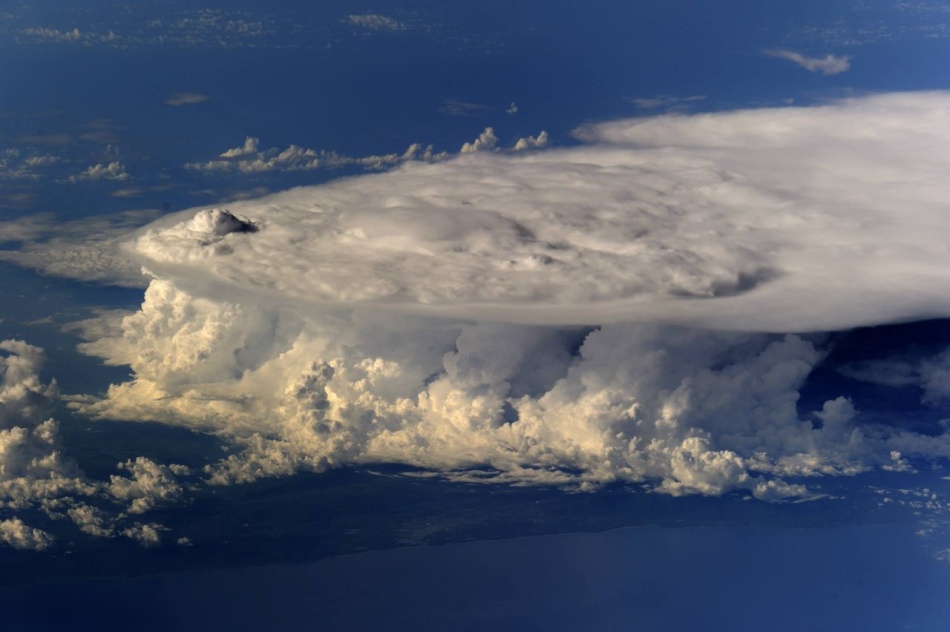
Clouds:

Ship "Union":

Africa:

Bering Sea:

Volga:

Moon

This is the most famous photograph of the Rise of the Earth, taken by the Apollo 8 astronauts on December 24, 1968. Paradoxically, but flying to the moon, we discovered the earth. And thanks to the Lunar Reconnaissance Orbiter probe, which has been orbiting the Moon since 2009, we can look at the reconstruction of this event:
And the next video is a stabilized survey of the Apollo 16 astronauts. The camera was on the chest of the spacesuit on a fairly rigid mount, so the original video shook much, but thanks to modern software we can see a much more comfortable picture of trips on the moon car :
Mars
Now on Mars is a very active "moving" of robots - three orbiters, two rovers, and two more vehicles on approach. And thanks to the Mars Reconnaissance Orbiter probe, we can admire the alien beauties:
Victoria Crater, one of the goals of the Opportunity rover.

And this spectacle is impossible in terrestrial conditions. Photographed polar region of Mars in the spring. Snow from carbon dioxide melts and turns into gas immediately, bypassing the liquid phase. Emissions of gas capture the ground, brown “panicles” in the photo are emissions of gas geysers.

The following video shows a technically very difficult process for landing the Curiosity rover . Video is stabilized by software processing, which greatly improves the viewing convenience.
And this is the sunset on Mars. Because of the dust in the atmosphere, it is blue. It seems to be a trifle, but impressive.
Beyond the orbit of mars
Fresh footage of Comet Churyumov-Gerasimenko taken by the Rosette probe </ a, which flew to the comet for a full ten years.
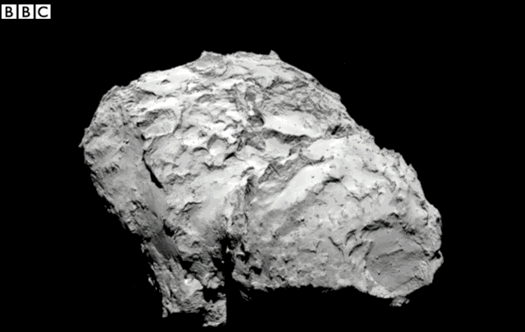
And this is the unique landing of the Huygens probe on the Titan. Titan is the largest satellite of the Saturn system, the only one of all the satellites of the Solar system covered with an opaque atmosphere. Only the landing gear could tell what was on the surface:
Reconstruction of the landing, you can get an idea of how the landing gear looks like:
A large red spot on Jupiter, a giant vortex larger than the Earth, shooting the Voyager-1 vehicle:
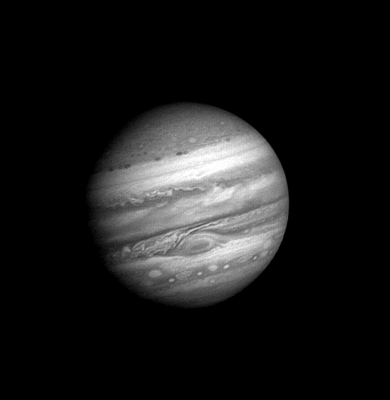
Hexagonal whirlwind on Saturn. It was reproduced on Earth: rotating rings were placed in a thirty-liter tank with rotating water. At different speeds of the rings, oval, triangular, hexagonal, etc. were obtained. whirlwinds.
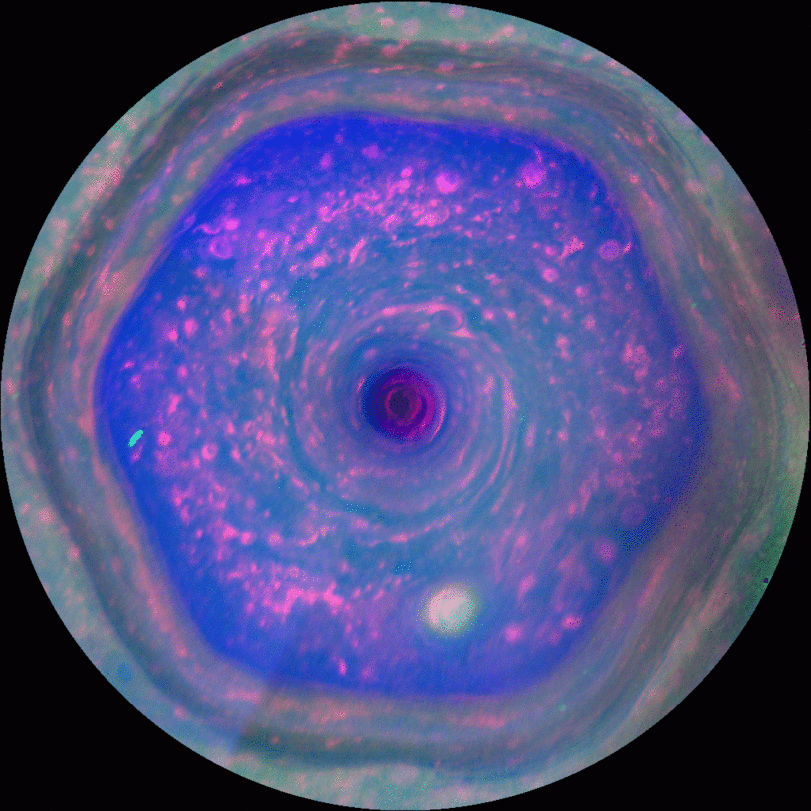
Video from photographs of the Voyagers and Cassini probes:
So what is next?
This video is fantastic. But still I would like to hope that at least our descendants will see such pictures from interstellar probes or manned spacecraft. There is very often the phrase Tsiolkovsky repeated in conversations about astronautics, it is very well-worn, but you still can’t say better: “The earth is the cradle of humanity, but you cannot live forever in the cradle”.
Materials from the lecture
A couple of photos:
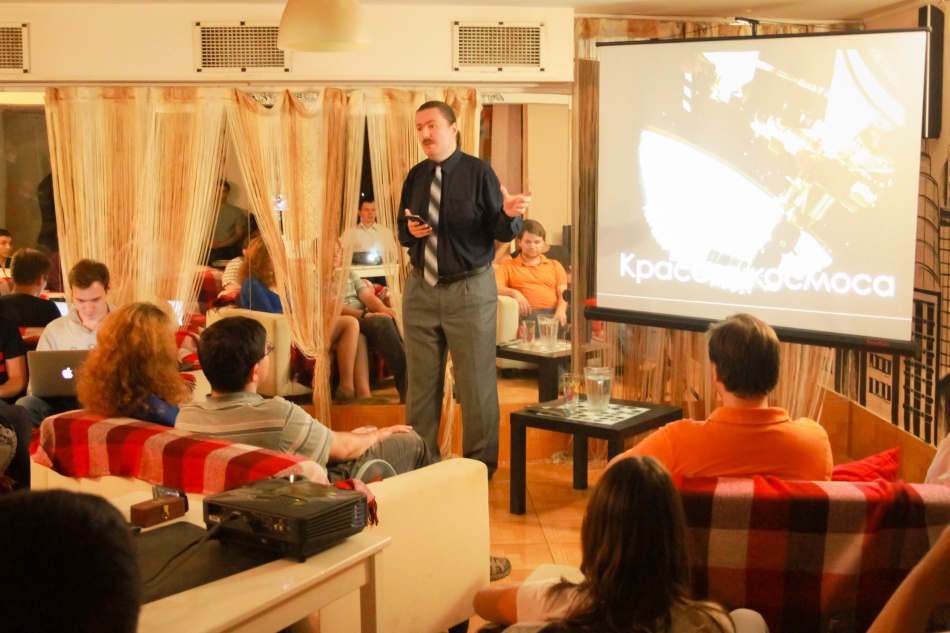
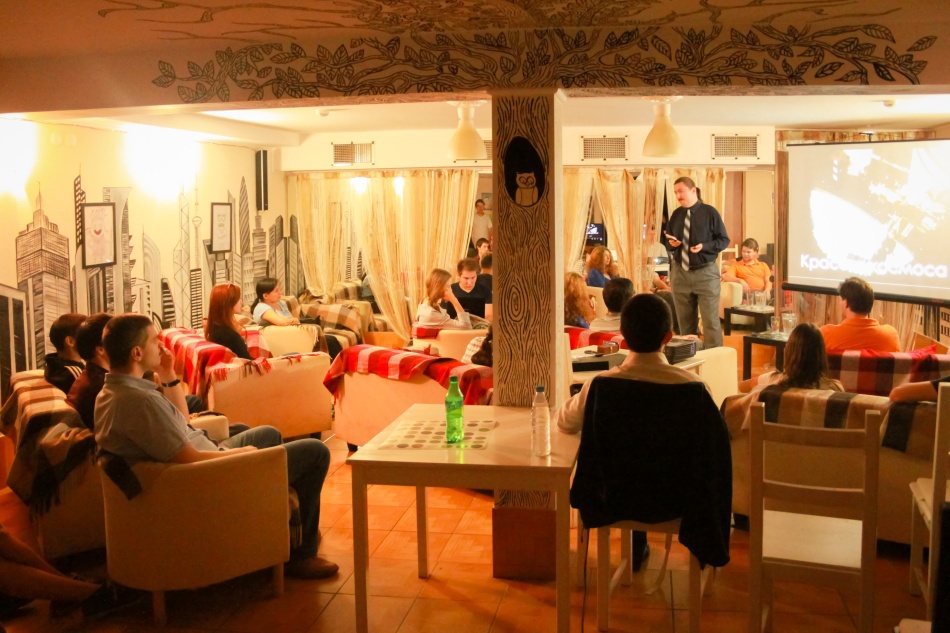
Link to the presentation. Use for popular science lectures is highly appreciated .
Link to presentations by Alexander Shaenko (also available for use) .
Video of the first part of the lecture. Unfortunately, the second part is not recorded for unknown reasons. There are some chances for materials from another device that also kept a record.
After the lecture, feedback forms were distributed. 22 forms were completed (there were about 30 people at the lecture), the assessment of the content of the lecture was 4.54 out of 5, the assessment of the form of the lecture (presentation of the material) was 4.59. Judging by the reviews, the audience liked it, repeatedly received requests to continue this undertaking.
Special thanks to the antikafe "GoodZone" , which made the audience free to a lecture.
UPD : There was a video from the second device. And the quality is better and the lecture is almost complete.
Source: https://habr.com/ru/post/235057/
All Articles